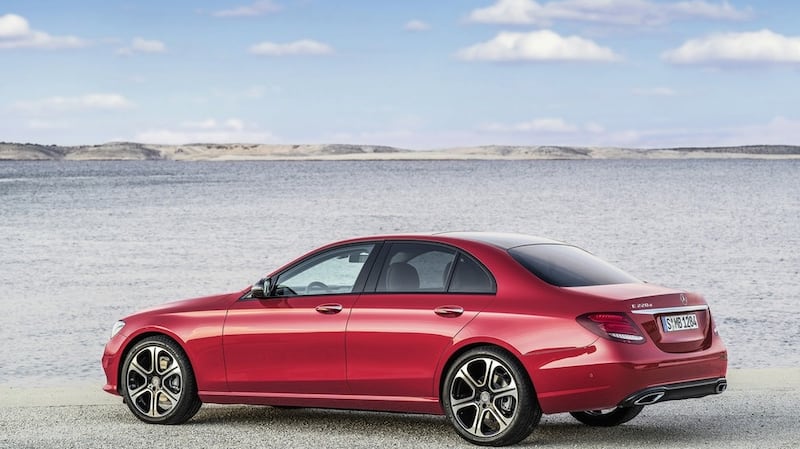It’s about to be a whole new world for Mercedes-Benz’s mid-sized mainstay, with the all-new E-Class debuting in Detroit a week after its top-secret images were leaked on a German website.
Pre-engineered for the expected arrival of autonomous driving deep into its lifecycle, the new W213 E- Class is longer than the current car, with an exterior design that links the C-, E- and S-classes more closely than at any point in recent history.
Benz claims the new fifth-generation E-Class will set new standards in the class, and it will need to because BMW’s next all-new 5-Series is also due this year and Audi’s next A6 due to land in 2017 – and it doesn’t always pay to be first in the cycle.


It will be longer inside than its predecessor, with an additional 65mm, to take the wheelbase up to 2,939mm, yet its overall length only increases 43mm to 4,923mm.
Mercedes also promises the new car will be lighter, spec for spec, than its predecessor, and an array of eight engines will provide the motivation, led by a fuel-sipping 2.1-litre turbodiesel four with a claimed 3.9 litres/100km NEDC consumption figure.
One transmission
In news sure to shake Germany’s Uber-halting taxi industry, the entire E-Class range will share just one transmission, the in-house nine-speed automatic, including AMG’s E 63.
It will score its fuel efficiency improvements thanks to engine and transmission upgrades, but also to improvements in start-stop technology and a drag coefficient of just 0.23, to lead the class.
Externally, the E-Class will carry over from both the C- and S-Classes by using the long nose, short tail proportions, along with the smoother nose shape and slightly coupe-esque rear roofline.
It pushes its own production limits on automated driving, allowing a new step, dubbed Drive Pilot, that lets drivers keep their hands off the wheel for extended periods on motorways and highways at up to 210km/h.
The car uses a combination of its own satellite navigation mapping, the radar cruise control inputs, lines on the road and roadside infrastructure to keep itself on line without steering input. Other cars already do similar things for limited periods, such as Audi's A4, A6, A7, A8 and Q7 and the BMW 5- and 7-Series models.
Inherited layout
Cynics might say they’re simply putting an umbrella name on an existing technology, but Benz insiders say the system is a genuine advance and that the name will continue as its autonomous technology develops.
Inside, it inherits the two- screen dash layout combination from the S-Class, but the technology is more mature than when the big limousine delivered it. The E-Class still uses two 12.3-inch display screens, but places them behind one single, long sheet of protective glass, then shrouds it all with a single, clean visor. The screen directly in front of the driver contains the traditional instrument cluster, which can be rearranged from three pre-selected layouts, and both screens run to 1,920 x 720 pixels.
The E-Class will also introduces Blackberry-style touch scrollers onto the steering wheel’s horizontal spokes to allow drivers control the car’s systems without taking hands off the steering wheel. Those systems have all been overhauled, with Benz redefining the user interface of its multi-media systems, despite years of telling us their units were more intuitive than anything from its rivals.
There is redundancy built into all of it, with the driver able to manage multi-media menus from the new steering-wheel scrollers, which have adjustable sensitivity, or the traditional wheel controller in the centre console. There will also be an optional touchpad, so passengers can write down their requests or inputs, then the car will read them back so the driver can confirm their accuracy.
Buyers of the cheaper versions of the interior won’t be quite so well catered for, though, with the entry-level models receiving traditional twin-tube dash layouts (one for the tacho, one for the speedo) with a small digital display screen between them and a small, traditional satnav screen in the middle of the dash.
Like the BMW 7-Series, the E-Class will deliver self-parking, controlled via a smartphone app, so the car will park itself in garages or tight parking spaces.
The smartphone used by just about every E-Class owner will take on a greater presence with the new version, and owners can use it as a key via Near Field Communication technology. Phones will also be used to help the car communicate with other cars on the road, effectively giving the car “eyes” further up the road so it can have more time to avoid problems and potential hazards.
Underneath all this user-interactive stuff, the E-Class will ride on steel springs in its standard specifications, while there are three versions of the optional adaptive damping system that range from a focus on comfort to athleticism.
There will be an all-new four-cylinder petrol engine in the E200, with either 134kW of 180kW of power. Its packaging possibilities have Benz excited, because it’s shorter than the old engine thanks to shrunken bore spacings (90mm, down from 94mm). It will also provide the basis of its in-line six-cylinder engine in future models.
A new diesel also arrives in the E220 d, while there’s also a now-compulsory plug-in hybrid, dubbed E 350 e, with 30km of claimed pure-electric range. It won’t lack for performance, though, with 205kW of power and 600Nm of system torque and a sprint to 100km/h in 6.2 seconds.
The hybrid will also deliver a CO2 emission figure of 2.1 gms/ km, making it by far the most efficient E-Class in the range – at least on the NEDC cycle.
The E200’s four-cylinder 2.0-litre produces 134kW of power, while the base diesel delivers 143kW and 102 grams of CO2/km.
A V6 turbodiesel will sit above this engine, with190kW and 620Nm, complete with exhaust recirculation technology and urea injection to minimise NOx emissions.
The other four-cylinder petrol motor will deliver 135kW and 180kW, while a V6 petrol motor delivers 245kW of power.










